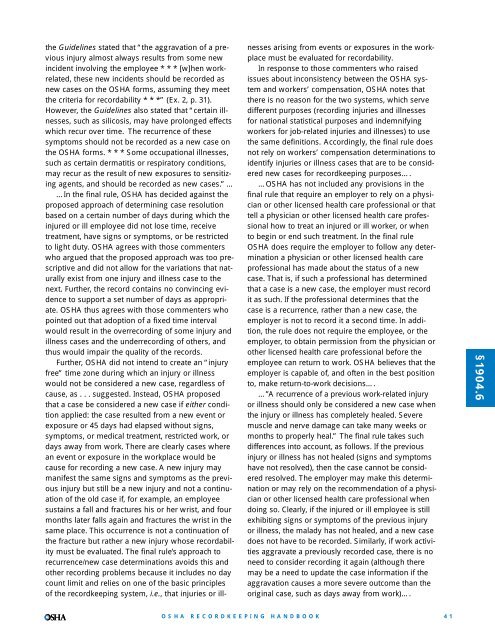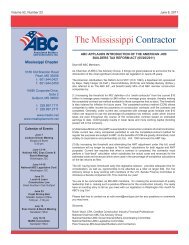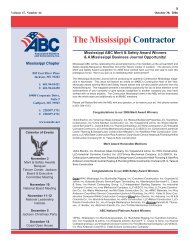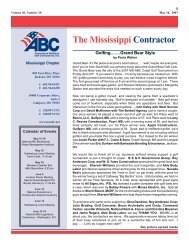§1904.6that the two injuries or illnesses are unrelated events,and that each represents an injury or illness thatmust be separately evaluated for its recordability.However, it is sometimes difficult to determinewhether signs or symptoms are due to a new eventor exposure, or are a continuance of an injury or illnessthat has already been recorded. This is animportant distinction, because a new injury or illnessrequires the employer to make a new entry on the<strong>OSHA</strong> 300 Log, while a continuation of an old recordedcase requires, at most, an updating of the originalentry. Section 1904.6 of the final rule being publishedtoday explains what employers must do to determinewhether or not an injury or illness is a new casefor recordkeeping purposes.The basic requirement at Section 1904.6(a) statesthat the employer must consider an injury or illness anew case to be evaluated for recordability if (1) theemployee has not previously experienced a recordedinjury or illness of the same type that affects thesame part of the body, or (2) the employee previouslyexperienced a recorded injury or illness of thesame type that affected the same part of the bodybut had recovered completely (all signs and symptomsof the previous injury or illness had disappeared)and an event or exposure in the work environmentcaused the injury or illness, or its signs orsymptoms, to reappear.The implementation question at Section1904.6(b)(1) addresses chronic work-related casesthat have already been recorded once and distinguishesbetween those conditions that will progresseven in the absence of workplace exposure andthose that are triggered by events in the workplace.There are some conditions that will progress even inthe absence of further exposure, such as some occupationalcancers, advanced asbestosis, tuberculosisdisease, advanced byssinosis, advanced silicosis, etc.These conditions are chronic; once the disease iscontracted it may never be cured or completelyresolved, and therefore the case is never “closed”under the <strong>OSHA</strong> recordkeeping system, even thoughthe signs and symptoms of the condition may alternatebetween remission and active disease.However, there are other chronic work-related illnessconditions, such as occupational asthma, reactiveairways dysfunction syndrome (RADs), and sensitization(contact) dermatitis, that recur if the ill individualis exposed to the agent (or agents, in the caseof cross-reactivities or RADs) that triggers the illnessagain. It is typical, but not always the case, for individualswith these conditions to be symptom-free ifexposure to the sensitizing or precipitating agentdoes not occur.The final rule provides, at paragraph (b)(1), thatthe employer is not required to record as a new casea previously recorded case of chronic work-related illnesswhere the signs or symptoms have recurred orcontinued in the absence of exposure in the workplace.This paragraph recognizes that there are occupationalillnesses that may be diagnosed at somestage of the disease and may then progress withoutregard to workplace events or exposures. Such diseases,in other words, will progress without furtherworkplace exposure to the toxic substance(s) thatcaused the disease. Examples of such chronic workrelateddiseases are silicosis, tuberculosis, andasbestosis. With these conditions, the ill worker willshow signs (such as a positive TB skin test, a positivechest roentgenogram, etc.) at every medical examination,and may experience symptomatic bouts asthe disease progresses.Paragraph 1904.6(b)(2) recognizes that manychronic occupational illnesses, however, such as occupationalasthma, RADs, and contact dermatitis, aretriggered by exposures in the workplace. Thedifference between these conditions and thoseaddressed in paragraph 1904.6(b)(1) is that in thesecases exposure triggers the recurrence of symptomsand signs, while in the chronic cases covered in theprevious paragraph, the symptoms and signs recureven in the absence of exposure in the workplace.This distinction is consistent with the position takenby <strong>OSHA</strong> interpretations issued under the formerrecordkeeping rule (see the Guidelines discussionbelow). The Agency has included provisions related tonew cases/continuations of old cases in the final ruleto clarify its position and ensure consistent reporting.Paragraph 1904.6(b)(3) addresses how to record acase for which the employer requests a physician orother licensed health care professional (HCP) to makea new case/continuation of an old case determination.Paragraph (b)(3) makes clear that employers areto follow the guidance provided by the HCP for<strong>OSHA</strong> recordkeeping purposes. In cases where twoor more HCPs make conflicting or differing recommendations,the employer is required to base his orher decision about recordation based on the mostauthoritative (best documented, best reasoned, ormost persuasive) evidence or recommendation.The final rule’s provisions on the recording of newcases are nearly identical to interpretations of newcase recordability under the former rule. <strong>OSHA</strong> hashistorically recognized that it is generally an easiermatter to differentiate between old and new casesthat involve injuries than those involving illnesses:40<strong>OSHA</strong> RECORDKEEPINGHANDBOOK
the Guidelines stated that “the aggravation of a previousinjury almost always results from some newincident involving the employee * * * [w]hen workrelated,these new incidents should be recorded asnew cases on the <strong>OSHA</strong> forms, assuming they meetthe criteria for recordability * * *” (Ex. 2, p. 31).However, the Guidelines also stated that “certain illnesses,such as silicosis, may have prolonged effectswhich recur over time. The recurrence of thesesymptoms should not be recorded as a new case onthe <strong>OSHA</strong> forms. * * * Some occupational illnesses,such as certain dermatitis or respiratory conditions,may recur as the result of new exposures to sensitizingagents, and should be recorded as new cases.” ……In the final rule, <strong>OSHA</strong> has decided against theproposed approach of determining case resolutionbased on a certain number of days during which theinjured or ill employee did not lose time, receivetreatment, have signs or symptoms, or be restrictedto light duty. <strong>OSHA</strong> agrees with those commenterswho argued that the proposed approach was too prescriptiveand did not allow for the variations that naturallyexist from one injury and illness case to thenext. Further, the record contains no convincing evidenceto support a set number of days as appropriate.<strong>OSHA</strong> thus agrees with those commenters whopointed out that adoption of a fixed time intervalwould result in the overrecording of some injury andillness cases and the underrecording of others, andthus would impair the quality of the records.Further, <strong>OSHA</strong> did not intend to create an “injuryfree” time zone during which an injury or illnesswould not be considered a new case, regardless ofcause, as . . . suggested. Instead, <strong>OSHA</strong> proposedthat a case be considered a new case if either conditionapplied: the case resulted from a new event orexposure or 45 days had elapsed without signs,symptoms, or medical treatment, restricted work, ordays away from work. There are clearly cases wherean event or exposure in the workplace would because for recording a new case. A new injury maymanifest the same signs and symptoms as the previousinjury but still be a new injury and not a continuationof the old case if, for example, an employeesustains a fall and fractures his or her wrist, and fourmonths later falls again and fractures the wrist in thesame place. This occurrence is not a continuation ofthe fracture but rather a new injury whose recordabilitymust be evaluated. The final rule’s approach torecurrence/new case determinations avoids this andother recording problems because it includes no daycount limit and relies on one of the basic principlesof the recordkeeping system, i.e., that injuries or illnessesarising from events or exposures in the workplacemust be evaluated for recordability.In response to those commenters who raisedissues about inconsistency between the <strong>OSHA</strong> systemand workers’ compensation, <strong>OSHA</strong> notes thatthere is no reason for the two systems, which servedifferent purposes (recording injuries and illnessesfor national statistical purposes and indemnifyingworkers for job-related injuries and illnesses) to usethe same definitions. Accordingly, the final rule doesnot rely on workers’ compensation determinations toidentify injuries or illness cases that are to be considerednew cases for recordkeeping purposes….…<strong>OSHA</strong> has not included any provisions in thefinal rule that require an employer to rely on a physicianor other licensed health care professional or thattell a physician or other licensed health care professionalhow to treat an injured or ill worker, or whento begin or end such treatment. In the final rule<strong>OSHA</strong> does require the employer to follow any determinationa physician or other licensed health careprofessional has made about the status of a newcase. That is, if such a professional has determinedthat a case is a new case, the employer must recordit as such. If the professional determines that thecase is a recurrence, rather than a new case, theemployer is not to record it a second time. In addition,the rule does not require the employee, or theemployer, to obtain permission from the physician orother licensed health care professional before theemployee can return to work. <strong>OSHA</strong> believes that theemployer is capable of, and often in the best positionto, make return-to-work decisions….…”A recurrence of a previous work-related injuryor illness should only be considered a new case whenthe injury or illness has completely healed. Severemuscle and nerve damage can take many weeks ormonths to properly heal.” The final rule takes suchdifferences into account, as follows. If the previousinjury or illness has not healed (signs and symptomshave not resolved), then the case cannot be consideredresolved. The employer may make this determinationor may rely on the recommendation of a physicianor other licensed health care professional whendoing so. Clearly, if the injured or ill employee is stillexhibiting signs or symptoms of the previous injuryor illness, the malady has not healed, and a new casedoes not have to be recorded. Similarly, if work activitiesaggravate a previously recorded case, there is noneed to consider recording it again (although theremay be a need to update the case information if theaggravation causes a more severe outcome than theoriginal case, such as days away from work)….§1904.6<strong>OSHA</strong> RECORDKEEPINGHANDBOOK41
- Page 1 and 2: www.osha.govOSHARecordkeepingHandbo
- Page 3 and 4: OSHARecordkeeping HandbookThe Regul
- Page 5 and 6: ContentsRecordkeeping HandbookRoadm
- Page 7 and 8: Section 1904.40Providing records to
- Page 9 and 10: Section 1904.0Purpose(66 FR 6122, J
- Page 11 and 12: Section 1904.1Partial exemption for
- Page 13 and 14: Section 1904.2Partial exemption for
- Page 15 and 16: employees, to OSHA within 8 hours (
- Page 17 and 18: Partial Exemptions for Employers Un
- Page 19 and 20: Section 1904.4Recording criteria(66
- Page 21 and 22: Section 1904.5Determination of work
- Page 23 and 24: (b)(7) How do I decide if a case is
- Page 25 and 26: well, including providing informati
- Page 27 and 28: This exception, which responds to i
- Page 29 and 30: or she is in the work environment a
- Page 31 and 32: have occurred but for the occupatio
- Page 33 and 34: considered work-related. If an empl
- Page 35 and 36: Question 5-12. Is work-related stre
- Page 37 and 38: • The doctor described the illnes
- Page 39 and 40: Scenario 7:• A site hired numerou
- Page 41 and 42: Letter of interpretation related to
- Page 43 and 44: These principles should be applied
- Page 45 and 46: The problem with the response is tw
- Page 47: Section 1904.6Determination of new
- Page 51 and 52: estricted work. If the case is a pr
- Page 53 and 54: • The doctor also prescribed the
- Page 55 and 56: • The employees were under the di
- Page 57 and 58: Section 1904.7General recording cri
- Page 59 and 60: (iii) Do I have to record restricte
- Page 61 and 62: of the length of time the employee
- Page 63 and 64: then result in days away from work
- Page 65 and 66: A partial day of work is recorded a
- Page 67 and 68: In all other respects, the final ru
- Page 69 and 70: ments. The Agency believes that the
- Page 71 and 72: e recorded because it will require
- Page 73 and 74: However, episodes of fainting from
- Page 75 and 76: care professional, he or she may al
- Page 77 and 78: “Other simple means” of removin
- Page 79 and 80: For purposes of OSHA recordkeeping
- Page 81 and 82: • When answering the doctor’s q
- Page 83 and 84: Response: In the recordkeeping regu
- Page 85 and 86: Letter of interpretation related to
- Page 87 and 88: Section 1904.8Recording criteria fo
- Page 89 and 90: caused by contaminated needles and
- Page 91 and 92: Section 1904.9Recording criteria fo
- Page 93 and 94: Section 1904.10Recording criteria f
- Page 95 and 96: hearing loss case that is not relat
- Page 97 and 98: average of 10 decibels or more at 2
- Page 99 and 100:
argued that because the function of
- Page 101 and 102:
occurs, and where hearing loss can
- Page 103 and 104:
cases in their workplace via analys
- Page 105 and 106:
March 4, 2004Mr. Carl O. Sall, CIHD
- Page 107 and 108:
When the professional evaluating th
- Page 109 and 110:
(2) May I line-out or erase a recor
- Page 111 and 112:
Section 1904.12Recording criteria f
- Page 113 and 114:
These new statistics would add only
- Page 115 and 116:
Sections 1904.13 - 1904.28 Reserved
- Page 117 and 118:
two lines of the OSHA 300 Log to de
- Page 119 and 120:
which replace the OSHA 200 and 101
- Page 121 and 122:
different types of occupational ill
- Page 123 and 124:
OSHA 301 form. These data are usefu
- Page 125 and 126:
LETTERS OF INTERPRETATION: Section
- Page 127 and 128:
Question 2: Under 29 CFR Section 19
- Page 129 and 130:
and has adopted language in the fin
- Page 131 and 132:
Section 1904.31Covered employees(66
- Page 133 and 134:
label assigned to a worker is immat
- Page 135 and 136:
These workers should be evaluated j
- Page 137 and 138:
Response: A case is work-related if
- Page 139 and 140:
Response: Section 1904.31 states th
- Page 141 and 142:
Thank you for your interest in occu
- Page 143 and 144:
year covered by the summary. The su
- Page 145 and 146:
2. Number of employees and hours wo
- Page 147 and 148:
LETTERS OF INTERPRETATION: Section
- Page 149 and 150:
Section 1904.33Retention and updati
- Page 151 and 152:
June 23, 2003Mr. Edwin G. Foulke, J
- Page 153 and 154:
Section 1904.34Change in business o
- Page 155 and 156:
PREAMBLE DISCUSSION: Section 1904.3
- Page 157 and 158:
Incident Report (Forms 300 and 301,
- Page 159 and 160:
workers’ compensation claim. See
- Page 161 and 162:
LETTERS OF INTERPRETATION: Section
- Page 163 and 164:
Letter of interpretation related to
- Page 165 and 166:
Question 3: Using the facts in Ques
- Page 167 and 168:
Section 1904.37State recordkeeping
- Page 169 and 170:
tion, require employers to report f
- Page 171 and 172:
(5) If I receive a variance, may th
- Page 173 and 174:
Section 1904.39Reporting fatalities
- Page 175 and 176:
gation. Therefore, the final rule d
- Page 177 and 178:
Section 1904.40Providing records to
- Page 179 and 180:
ness. The government inspector may
- Page 181 and 182:
Response: The controlling employer
- Page 183 and 184:
FREQUENTLY ASKED QUESTIONS: Section
- Page 185 and 186:
OSHA and the BLS have worked togeth
- Page 187 and 188:
provide copies of the retained reco
- Page 189 and 190:
FREQUENTLY ASKED QUESTIONS: Section
- Page 191 and 192:
Section 1904.46Definitions(66 FR 61
- Page 193 and 194:
of business information. For exampl
- Page 195 and 196:
inconvenience associated with keepi
- Page 197 and 198:
skin disease, respiratory disorder,
- Page 199 and 200:
Question 2: Under 29 CFR Section 19
- Page 201:
www.osha.gov







